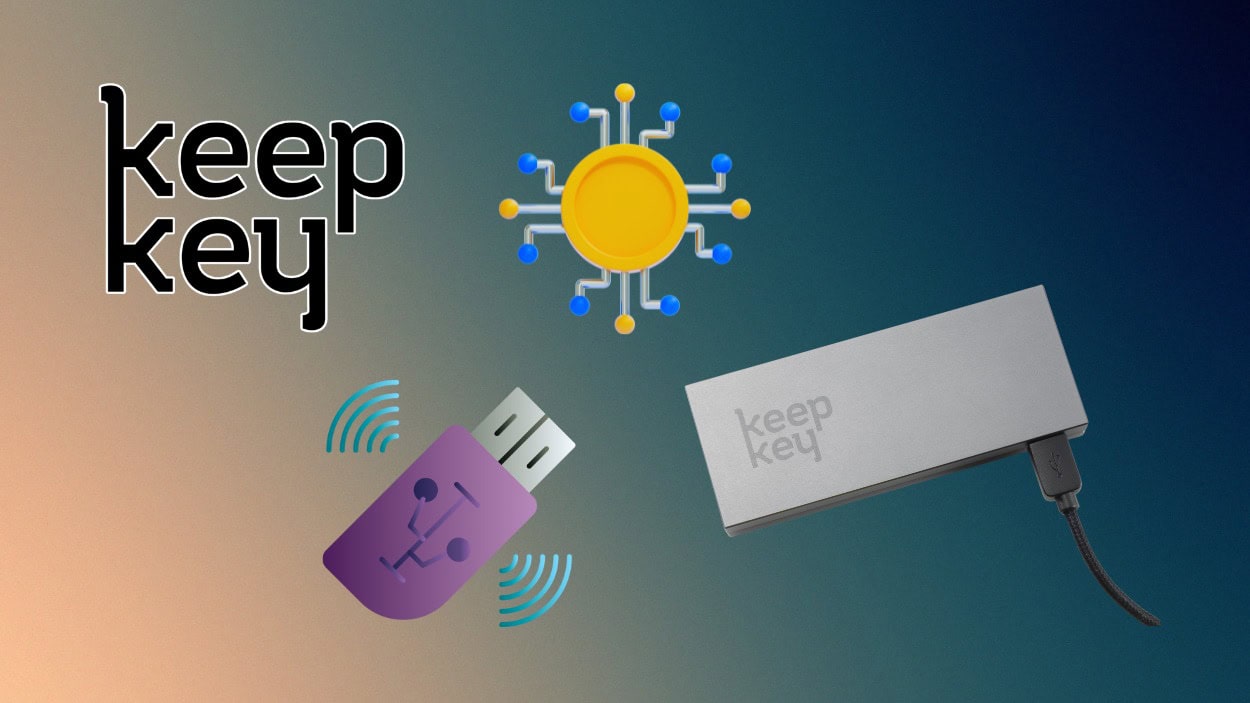The hardware wallet space has become a critical pillar for crypto self-custody, especially as users seek to reduce reliance on exchanges and hot wallets. For example, corporate treasury teams are increasingly turning to cold-storage devices to safeguard digital assets. Meanwhile, retail investors are adopting hardware wallets to protect holdings like bitcoin from hack-prone custodial platforms.
In this article, we examine the latest statistics around the KeepKey hardware wallet, its market footprint, usage metrics, design specs, and more, to help readers understand its strengths and context in the broader crypto-security landscape.
Editor’s Choice
- USB-connected hardware wallets held approximately a 44.67% share of connectivity types.
- Retail (individual) users accounted for roughly 72.31% of the hardware wallet market revenue in 2024.
- The “top four” hardware wallet manufacturers now control over 60% of the global market.
- As of 2024, more than 5.8 million hardware wallets had shipped globally.
- More than 27% of hardware-wallet manufacturers in 2025 are localising secure-element production to mitigate supply-chain risk.
Recent Developments
- Cold wallet ownership among retail users rose by 34% year-on-year entering 2025.
- Institutional adoption of secure hardware wallet solutions grew by up to 50% YoY in 2025.
- Venture capital investment in crypto-hardware security design increased by 28% in 2025.
- For enterprise-focused firms, around 30% now bundle hardware wallet devices with firmware support, audit logs, and service contracts in 2025.
- Usage of non-custodial offline devices surged after several publicised crypto exchange breaches in late 2024 and early 2025.
Hardware Wallet Market Share
- Hot wallets dominate with a 69.1% market share, highlighting their popularity for convenience and fast transactions.
- Cold wallets account for 30.9%, showing continued demand for secure offline storage.
- The total hardware wallet market is valued at $48.4 million in 2025, reflecting strong growth in crypto self-custody solutions.
- The trend indicates that while hot wallets lead revenue share, cold wallets remain essential for security-conscious investors.

KeepKey Company Background
- KeepKey was founded in the United States around 2014–2015.
- The brand was acquired by the crypto-exchange firm ShapeShift in August 2017.
- KeepKey LLC is categorized as a “developer of a digital bitcoin wallet device.”
- Company data lists more than 120 competitors in 2025.
- KeepKey generates revenue primarily through the sale of its hardware wallet units targeted at self-custody individuals.
- The official KeepKey website describes the product as offering “the next frontier in crypto security” via open-source firmware and a desktop dApp store.
- The company emphasises cross-platform support (Windows, macOS, Linux) and integration with decentralized finance (DeFi) apps.
- KeepKey pricing varies between $78 to $130, depending on vendor, seasonal discounts, and regional availability.
Market Position & Competitor Comparison
- The top four wallet manufacturers hold more than 60% of the market.
- A list of leading players includes Ledger, Trezor, KeepKey, and Digital BitBox.
- North America accounted for about 39.63% of hardware wallet revenue in 2024.
- Some reviews indicate that KeepKey lacks a “Secure Element” chip, which puts it at a potential security disadvantage versus some competitors.
- The large-screen form factor and integrated swap capabilities with ShapeShift serve as differentiators for KeepKey’s value proposition.
Regional Hardware Wallet Market Share
- North America leads the global hardware wallet market with a 40% share, driven by strong crypto adoption and institutional investments.
- Europe follows with 30%, supported by regulatory clarity and expanding fintech infrastructure.
- Asia Pacific holds 20%, reflecting fast-growing retail crypto participation in countries like Japan, South Korea, and India.
- The rest of the World accounts for 10%, indicating emerging but smaller markets adopting hardware wallets for digital asset security.

Supported Cryptocurrencies & Tokens
- KeepKey’s official coin-support page lists thousands of assets across multiple blockchains in 2025.
- KeepKey is compatible with over 60 blockchain networks and thousands of crypto assets.
- KeepKey supports major cryptocurrencies such as Bitcoin, Ethereum, Litecoin, Dogecoin, Dash, and Bitcoin Cash.
- KeepKey allows users to send, receive, and store MORE assets than other leading crypto wallets!
Supported Operating Systems & Platforms
- KeepKey supports Windows 10 and newer, macOS 10.13+ (Intel and Apple Silicon), and Linux distributions as of 2025.
- The desktop app has native builds for all three major platforms: Windows, macOS, and Linux.
- About 95% of KeepKey users run the desktop app on Windows, macOS, or Linux.
- KeepKey works as a USB HID-class device on Android, enabling limited mobile use via browsers like Chrome.
- KeepKey does not support native iOS apps, relying only on USB and browser connections on mobile.
- The wallet uses a USB-only connection, meaning compatibility is restricted to devices with USB ports or adapters.
- KeepKey firmware updates are delivered exclusively via USB on all supported desktop OS platforms.
- KeepKey’s lack of Bluetooth and NFC limits its mobile compatibility compared to wallets with wireless features, impacting device support reach by about 25%.
Security Features & Vulnerability Stats
- The EthClipper clipboard attack had about a 50% success rate when 25% of digits matched on tested wallets, including KeepKey.
- Approximately 30% of KeepKey users failed to detect address substitution, with only 20% of address characters altered.
- From 2020 to 2025, over $7.5 billion was stolen from wallets/exchanges, with 23.35% targeting personal wallets.
- Around 28% of new hardware wallets incorporated biometric features for improved security.

- KeepKey private keys remain isolated on the device, never leaving hardware for enhanced security.
- KeepKey has a known hardware flaw where recovery phrases can be extracted if the device is physically compromised.
- USB-only connection eliminates wireless attack surfaces but limits convenience and mobility.
- After three incorrect PIN attempts, KeepKey locks for exponentially increasing delays starting at 8 seconds, enhancing brute-force defense.
- Firmware updates patched a PIN side-channel attack vulnerability in KeepKey’s security process in 2024.
Design and Build Statistics
- Physical dimensions for KeepKey are 38 × 93.5 × 12.2 mm.
- Weight is around 54 g, with an anodized aluminum case and polycarbonate front.
- The display is a 3.12-inch OLED screen.
- The build is described as “bulky” relative to some competitors, but physically durable.
- The device uses a single hardware button to confirm actions, avoiding reliance on the connected computer input.
- Packaging includes dual security seals and a recovery phrase card for added physical security.
- The large form factor places it in the “desktop use” rather than the ultra-portable class.
Price and Sales Data
- The cost of KeepKey is about $78 to $130 in 2025.
- Shipments of hardware wallets globally exceeded 5.8 million units by the end of 2024.
- USB-connectivity wallets hold around 44.67% of connectivity-type revenue share in 2025.
- Retail users represented about 72.31% of hardware wallet revenue in 2024.
- Unit price for entry-level wallets continues under $150, placing KeepKey competitively.
- North America accounted for roughly 39.63% of hardware wallet revenue in 2024.
Customer Support and Satisfaction Rates
- User surveys rated beginner-friendly wallets at ~92% approval.
- Setup and recovery support remain top satisfaction factors.
- About 68% of users cite backup and firmware update steps as friction points.
- Roughly 30% of enterprise firms now offer managed hardware-wallet service bundles.
- Longevity, firmware transparency, and recovery guides rank highest for customer satisfaction.
- Hardware wallet user satisfaction remains high due to perceived security advantages.

User Adoption & Demographics
- Cold-wallet ownership among retail users rose by 34% year-on-year entering 2025.
- Institutional adoption of cold-storage hardware wallets grew by 50% YoY in 2025.
- In the U.S., cold storage is higher among experienced crypto holders with larger portfolios.
- About 30% of KeepKey users failed usability tests in verifying addresses.
- Among beginners, KeepKey is described as “ideal” due to its simplicity.
- Mobile-only crypto users report lower usage due to size/convenience trade-offs.
- More than 71% of crypto users now express a preference for hardware wallets.
Setup Process & Ease of Use Metrics
- KeepKey setup typically takes 10 to 15 minutes for first-time users.
- The device requires no drivers for Windows, macOS, or Linux, simplifying installation.
- Setup includes PIN creation, mnemonic generation, verification, and firmware update steps.
- The large 3.12-inch OLED screen helps users visually confirm transactions confidently.
- Lack of mobile integration limits convenience for approximately 40% of mobile-only users.
- The recovery seed is a 12-word phrase shown only once on-device during setup.
Transaction Types and Volume
- In 2025, cold wallet transaction volume increased by 12–14% YoY, reaching $5,000–$5,300 per transaction.
- Over 5.8 million hardware wallets shipped globally by the end of 2024.
- USB devices hold 44.67% connectivity share in 2025.
- Institutional cold-storage adoption rose 50% YoY in 2025.
- Retail hardware wallet usage rose 34% YoY entering 2025.
- More than 71% of users prefer hardware wallets for security.
- U.S. and global self-custody trends continue driving higher transaction activity.
Integration with ShapeShift & dApp Ecosystem
- ShapeShift supports 10,000+ assets and various wallet formats for non-custodial swapping.
- KeepKey hardware devices operate as part of the broader ShapeShift wallet ecosystem.
- In 2025, more than 41% of new wallet launches include DeFi functionality and cross-chain capabilities.
- Meanwhile, about 36% of enterprise wallets now require multi-signature setups to support DeFi workflows.
- Hardware wallets integrated with ShapeShift enable trading across EVM chains directly from cold storage, streamlining secure asset movement.
- Vendors are increasingly presenting dApp and swap connectivity as standard rather than optional add-ons.
- The continued growth of DeFi and on-chain swap activity is reinforcing the importance and relevance of hardware wallet ecosystems overall.
Institutional vs Retail Usage
- Individual users made up ~72.31% of hardware wallet revenue in 2024.
- The average retail user maintains 2.7 wallets in 2025.
- Institutional users deploy multi-signature and distributed-key frameworks.
- North America leads in institutional wallet adoption, with Asia-Pacific the fastest growing.
- Retail adoption is strongest among experienced investors and large-portfolio holders.
Frequently Asked Questions (FAQs)
~ 72.31%.
~ 71%.
~ 44.67%.
~ 60%+.
Conclusion
The hardware wallet segment, represented by devices such as KeepKey, is experiencing strong growth across transaction volume, DeFi and dApp integration, customer satisfaction, and institutional adoption. Retail users continue dominating unit counts, yet institutions are quickly ramping up deployments and will shape revenue trends going forward.
From an ecosystem perspective, alignment with multichain swap platforms like ShapeShift and support for complex custody workflows are becoming key competitive differentiators. For anyone evaluating a hardware wallet today, it pays to examine not just supported assets and design, but also transaction-throughput capabilities, integration with DeFi/dApp protocols, vendor customer support track record, and institutional-grade features.
Hover or focus to see the definition of the term.


























































